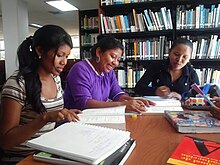
The indigenous peoples of South America are the Pre-Columbian peoples of South America and their descendants. These peoples contrast with South Americans of European ancestry.
In Spanish, indigenous people are often referred to as indígenas or pueblos indígenas (lit. indigenous peoples). They may also be called pueblos nativos or nativos (lit. native peoples). The term aborigen (lit. aborigine) is used in Argentina, and pueblos aborígenes (lit. aboriginal peoples) is commonly used in Chile. The English term "Amerindian" (short for "Indians of the Americas") is often used in the Guianas. People of mixed European and indigenous descent are usually referred to as mestizos.
It is believed that the first human populations of South America either arrived from Asia into North America via the Bering Land Bridge, and migrated southwards or alternatively from Polynesia across the Pacific.[1][2][3] The earliest generally accepted archaeological evidence for human habitation in South America dates to 14,000 years ago, the Monte Verde site in Southern Chile.[4] The descendents of these first inhabitants would become the indigenous populations of South America.
Before the Spanish colonization of the Americas, many of the indigenous peoples of South America were hunter-gatherers, and indeed many still are, especially in the Amazonian area. Others, especially the Andean cultures, practiced sophisticated agriculture, utilized advanced irrigation and kept domesticated livestock, such as llamas and alpacas.[5][6][7] After the arrival of Europeans in 1492 the indigenous population of South America fell rapidly due to a variety of factors, such as disease and warfare.[8]

In the present day, there are two South American countries where indigenous peoples constitute the largest ethnic group. These are Peru, where 45% are indigenous, and Bolivia, where 62% of people identify as feeling a part of some indigenous group.[9][10]
South American indigenous peoples include:
- Indigenous peoples in Argentina
- Indigenous peoples in Bolivia
- Indigenous peoples in Brazil
- Indigenous peoples in Chile
- Indigenous peoples in Colombia
- Indigenous peoples in Ecuador
- Indigenous peoples in French Guiana
- Indigenous peoples in Guyana
- Indigenous peoples in Paraguay
- Indigenous peoples in Peru
- Indigenous peoples in Suriname
- Indigenous peoples in Uruguay
- Indigenous peoples in Venezuela
See also edit
External links edit
References edit
- ^ "Study confirms Bering land bridge flooded later than previously believed". cyberwest.com. Retrieved 2017-02-22.
- ^ "Gongora et al. 2008".
{{cite journal}}: Cite journal requires|journal=(help) - ^ http://www.jps.auckland.ac.nz/document/?wid=1242.
{{cite web}}: Missing or empty|title=(help) - ^ Hey, Jody (2005-05-24). "On the Number of New World Founders: A Population Genetic Portrait of the Peopling of the Americas". PLOS Biology. 3 (6): e193. doi:10.1371/journal.pbio.0030193. ISSN 1545-7885. PMC 1131883. PMID 15898833.
{{cite journal}}: CS1 maint: unflagged free DOI (link) - ^ Earls, John. "The Character of Inca and Andean Agriculture" (PDF). Retrieved 22 February 2017.
- ^ "4.1 Raised beds and waru waru cultivation". www.oas.org. Retrieved 2017-02-22.
- ^ Pinedo, Javier Blossiers. "AGRICULTURA DE LADERAS A TRAVÉS DE ANDENES, PERÚ" (PDF). Archived from the original (PDF) on 14 December 2010. Retrieved 22 February 2017.
- ^ "Massive Population Drop Found for Native Americans, DNA Shows". 2011-12-05. Retrieved 2017-02-24.
- ^ "The World Factbook — Central Intelligence Agency". www.cia.gov. Retrieved 2017-02-24.
- ^ "The World Factbook — Central Intelligence Agency". www.cia.gov. Retrieved 2017-02-24.
